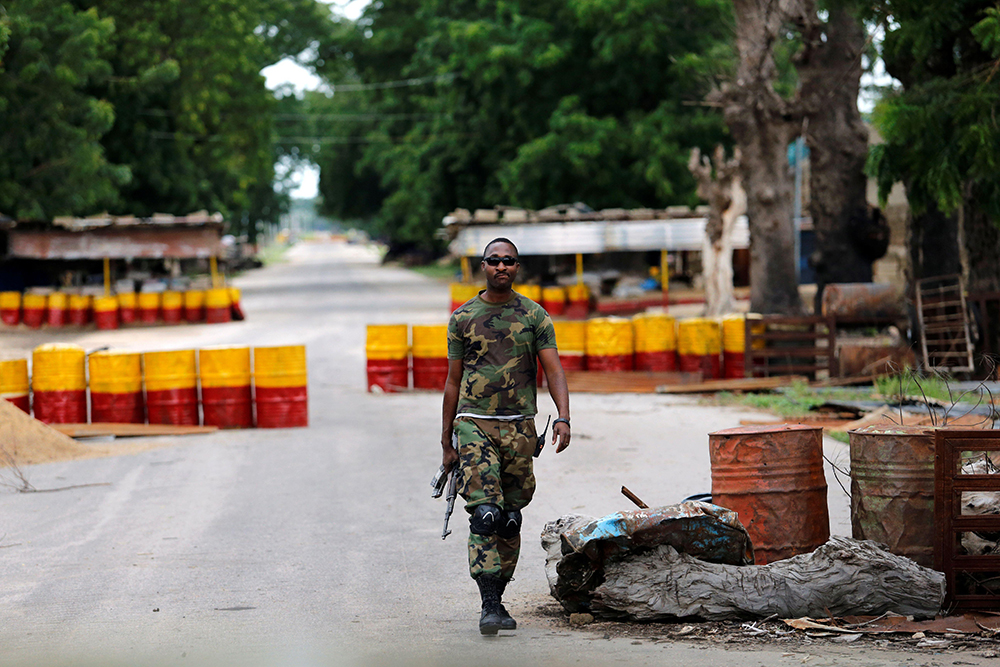Q&A with "Mobility, Mobilization, and Counter/Insurgency" Author, Daniel E. Agbiboa

This is a Q&A with Daniel E. Agbiboa, author of Mobility, Mobilization, and Counter/Insurgency: The Routes of Terror in an African Context from the University of Michigan Press. This book is available in hardcover, paper, and accessible e-book formats.
Mobility, Mobilization, and Counter/Insurgency draws creatively on mobile ethnographic methods of data collection. Can you describe some of these methods, and how these experiences helped shape the book?
To start with, my long-standing goal was to probe the role of mobility as a neglected aspect of insurgency and counterinsurgency and, in so doing, to reconfigure mobility as the central object of conflict inquiry rather than as a mere offshoot. In a special issue on (im)mobility in the journal Identities , the editors acknowledged, “None of the contributors began the research reported here by thinking about mobilities as such. Instead, issues related to (im)mobility arose from research on other topics: tourism, migration, and global flows of commodities.” Mobility, Mobilization, and Counter/Insurgency ’s mobile ethnographic approach stands in sharp contrast to typical earlier works that thus stumbled upon mobility.
Mobile ethnography is a creative and capacious approach to doing fieldwork that involves a kind of co-present immersion in which one travels with people—who, in my case, are stuck yet constantly on the move for survival income—as a form of sustained engagement with their subjective perspectives on their workaday world. Andre Novoa states the issue well: mobile ethnography is an invitation “to experience, feel and grasp the textures, smells, comforts and discomforts, pleasures and displeasures of a moving life. It means following people around and engaging with their worldviews. It means focusing on mobility.” That mobility not only constitutes the primary concern of Mobility, Mobilization, and Counter/Insurgency , but also structures its methodology. Taking to the road—in particular, dwelling at checkpoints located at the precarious and shifting margins of the state—enabled me to closely observe and describe the mobile subject on the move, the circulation of power relations across dangerous spaces where terror and extortion are always anticipated, and how place shapes the spatial tactics and maneuvers of people in transit. At the checkpoint, motorists are not just victims of state shakedowns; invariably, they are participants in a state-society “dance.” By participating in a moving field site (e.g., following road transport workers around and asking questions, listening, and observing en route), I gained a deeper understanding of their lived realities and navigational capacity. As an important dimension of fieldwork, mobility opened my eyes and ears to the ensemble of power relations and techniques that produce and reproduce mobile subjects and situate them within a context of calculated existence. In this, I operationalized the call by Akhil Gupta and James Ferguson for researchers to rethink the “idea of ‘the field’” as a form of mobile dwelling that legitimizes knowledge derived from shifting locations instead of bounded fields.
Why was it so important that you focus on the Boko Haram insurgency for your research?
[caption id="attachment_14848" align="alignnone" width="1024"]
Maiduguri Railway Terminus. (Photograph by Daniel E. Agbiboa.)[/caption]
I focused on the Boko Haram insurgency to illustrate the neglected linkages between mobility and conflict since the emergence and mutation of that insurgency best exemplifies how so many armed conflicts today tend to, quite literally, develop around the system of transportation and mobility and are simultaneously transformed by it. Most members of Boko Haram were young commercial motorcyclists (achaba drivers)—a favorite target of police enforcement and extortion in northeast Nigeria—who were recruited from stigmatized public transit spaces. The anger felt by these achaba drivers toward corrupt and time-wasting mobile police on the road likely helped Boko Haram’s anti-government ideals to gain traction in the achaba community and may have influenced many drivers to identify with the group.
In the book, I go into the significance of Boko Haram’s origins in the ruins of Maiduguri’s Railway Terminus. For decades, this “non-place”—marked by anonymity and depersonalization—has accommodated uprooted and displaced young people, who would go on to constitute the social base of Boko Haram. Many marginal and idle men who joined Boko Haram were recruited from this transit hub at the border of the Mafoni District, where Mohammed Yusuf, the founder of Boko Haram, retreated following his ideological differences and conflict with his teacher, Shaikh Jafar Mahmud Adam. Nigerian historian Moses Ochonu argues that under colonial administration in northern Nigeria, railway stations were seen as primary sites of subversion, labor activism, and crime. All this is to say that by focusing on the Boko Haram insurgency, this book is able to reclaim the story of mobility in northern Nigeria’s—and the Lake Chad Basin’s—long tradition of dissent and dissidence. As I thought about the move from the spatial turn to the mobilities turn in the social sciences, it became apparent to me that the dialectic of mobility and immobility not only are rooted in the longue durée perspective on the history of northeast Nigeria and the Lake Chad region (a poor region marked by itinerant and nomadic territoriality), but also take center stage in studying why a deadly jihadist group like Boko Haram exists and how the Nigerian state has responded.
How does your book add to research on mobilities? What can it add to security studies?
[caption id="attachment_14774" align="alignleft" width="444"]
Borno Express Transport Corporation, Main Terminus, Jos Road, Maiduguri. (Photograph by Daniel E. Agbiboa.)[/caption]
Let me begin by saying that until now, studies on mobility and security have been largely disconnected. Mobility researchers have paid scant attention to insurgency, and conflict scholars have been strangely silent on how insurgent violence is constantly reconfigured as it is shaped by and diffused through a series of (im)mobile entities. Therefore, my primary purpose in this book was to reclaim the logic of mobility in matrices of armed conflicts, with Africa’s Lake Chad Basin, especially northeast Nigeria, as a regional focus. By focusing on this region, my aim is to reconfigure the margins of the new mobilities paradigm, which invariably takes the Global North as the primary site of research and interest. Although that paradigm has become an increasingly mainstream notion in the social sciences, it remains tangential to security studies. Here, mobility is still considered in separate spheres, precluding the analytical insights of interdisciplinary approaches. I hope that Mobility, Mobilization, and Counter/Insurgency makes a seminal contribution to mobility and security studies by helping us not only to think through the multiple interacting mobilities (physical, social, informational, symbolic) that govern conflict terrains but also to hone in on how mobile subjects in extremis experience and articulate their world as they move through it. For the study of armed conflicts, I introduce a fresh framework that treats mobility as not just the mise en scène but the very medium for the experience and practice of counter/insurgency. By unsettling the dichotomy between mobility and security, I want to urge attention to the overlapping logics of different mobile groups—for example, motorists, militants, and military—in a climate of insecurity where constraints and movements are mutually reinforcing. The book's mobile ethnographic approach sheds new light onto how civilians in conflict produce meaning from the dangers and frictions of their mobilities, how they inhabit and socially navigate precarious routes, and how movement and stoppage impinges on their existential mobility. What immediately becomes clear is how issues of mobility can sometimes map onto the frustration of not moving well from being a youth to an adult; and how relative deprivation can be mapped from who can move and who cannot, who feels stuck and who does not.
How does your book contribute to the larger conversations around politics, especially in African nations?
My book lays bare the complex ways in which the dialectic of physical and social mobility intersects with the spatialization and materialization of power, inequality, and revolt in Africa, giving rise to a soro soke (“speak up”) citizenship. In point of fact, mobility is embedded in the word insurgence , from the Latin word insurgere , meaning to rise up in revolt. A study of mobility is necessarily a study of dissidence, protest, dissensus, sentiments, and political activism. And from anti-police brutality protesters in Nigeria to anti-coup protesters in Sudan, African politics has seen no shortage of that soro soke citizenship in recent years. In Mobility, Mobilization and Counter/Insurgency, I show how mobility is at the epicenter of dissent and disruption, the tactics that people at state margins and urban peripheries adopt in the face of unequal power relationships and historically legitimized systems of inequality, exploitation, and disposability.
[caption id="attachment_14772" align="aligncenter" width="1000"]
A soldier walks past a checkpoint in Bama, Borno State, Nigeria, August 31, 2016. REUTERS/Afolabi Sotunde[/caption]
What do you hope readers will take away from reading Mobility, Mobilization, and Counter/Insurgency?
While this book theoretically and empirically demonstrates how mobility and immobility are intrinsically interwoven in the context of the Boko Haram insurgency, its mobile logic is generalizable to a broad range of conflict zones, including the Central African Republic (CAR), Mali, Liberia, Colombia, Palestine, Afghanistan, and Sri Lanka. In the CAR conflict, for instance, Peer Schouten reminds us that the regulation and control of armed roadblocks and trade routes are key to conflict financing, and affirms the power and currency of mobile infrastructures and subjects. Similarly, in the Malian conflict, mobile strategies constitute the organizing logic of local Islamist assemblages, including Al-Qaeda in the Islamic Maghreb, Ansar Dine, and the Movement for Oneness and Jihad in West Afrcia. As Denis Retaille and Olivier Walther tell us, “For the Islamists, there was no question of saddling themselves with territory and using up their strength in controlling land areas. The control of movement and crossroads is enough to have power in a mobile space since places themselves are mobile.” What is unique about Mobility, Mobilization, and Counter/Insurgency is its careful attention to the imbrication of physical with social mobility in the context of counter/insurgency. My hope is that this book will inspire more and more researchers to interrogate how issues of mobility and security interpenetrate and shape each other, and how transit routes and mobile infrastructures constitute a dynamic space accounting for people’s daily and defiant struggles to negotiate crisis and impose order and predictability on their lives.






